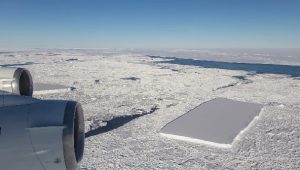28-09-2023
NEW YORK: Sea ice that covers the ocean around Antarctica hit a record low surface area in the winter, a preliminary analysis of US satellite data shows, and scientists fear the impact of climate change is increasing at the southern pole.
 As the southern hemisphere transitions into spring, Antarctic sea ice had reached only a maximum size of 16.96 million sq km (6.55 million sq miles) by September 10, the US space agency, NASA, and the National Snow and Ice Data Center (NSIDC) said on Monday.
As the southern hemisphere transitions into spring, Antarctic sea ice had reached only a maximum size of 16.96 million sq km (6.55 million sq miles) by September 10, the US space agency, NASA, and the National Snow and Ice Data Center (NSIDC) said on Monday.
“This is the lowest sea ice maximum in the 1979 to 2023 sea ice record by a wide margin,” said the NSIDC, a government-supported programme at the University of Colorado at Boulder.
At one point this year, sea ice had dropped to 1.03 million sq km (more than 397,000 sq miles), smaller than the previous record low and an area roughly the size of Texas and California combined.
“It’s a record-smashing sea ice low in the Antarctic,” NSIDC scientist Walt Meier said in comments published by NASA.
In February, at the height of the austral summer, the Antarctic sea ice pack had reached a minimum extent of 1.79 million sq km (more than 691,000 sq miles), also a record, according to the NSIDC.
The ice pack then grew back at an unusually slow pace despite the onset of winter.
 Meier said the growth in sea ice appeared “low around nearly the whole continent as opposed to any one region”.
Meier said the growth in sea ice appeared “low around nearly the whole continent as opposed to any one region”.
While the Arctic has been hit hard by climate change over the past decade with sea ice rapidly deteriorating as the northern region warms four times faster than the global average, it has been less certain how warming temperatures are impacting sea ice near the South Pole.
For several decades, the Antarctic sea ice pack had remained stable, even expanding slightly from 2007 to 2016 but “since August 2016, the Antarctic sea ice extent trend took a sharp downturn across nearly all months,” the NSIDC said.
The shift in recent years towards record-low conditions around the South Pole has scientists concerned climate change may finally be presenting itself in Antarctic sea ice. (Int’l Monitoring Desk)
 Pressmediaofindia
Pressmediaofindia




